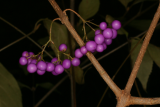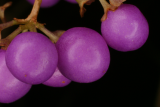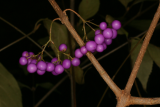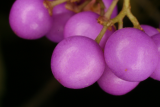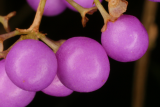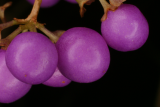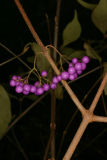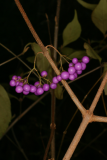Additional notes (click to expand)
Horticulture
Grow in fertile, well-drained soil, in sun or dappled shade. Root softwood cuttings, or semi-ripe cuttings with bottom heat in summer. Pest and disease trouble free.
Brickell, C. (2003). A-Z Encyclopedia of Garden Plants. Dorling Kindersley. p.209
Callicarpa japonica is a deciduous shrub growing to 2 m (6ft 7in) at a medium rate. It is in flower in August, and the purple berries ripen in October.
Plants for a Future (2015) at www.plantsforafuture.org.uk http://pfaf.org/user/Plant.aspx?LatinName=Callicarpa+japonica
link
Nomenclature
Callicarpa- from Greek, kalli-, beautiful; karpos, fruit.
Stearn, W.T. (1996). Dictionary of Plant Names for Gardeners. Cassell. p.76
In Japanese it is known as Murasaki, a word referring to the highly ornamental berries; purple being the most esteemed colour in Japan. This word is applied to any thing or person of extreme beauty or respect.
Other use
The North American- Callicarpa americana- the Alabama people used it in a sweat bath for malaria and rheumatism' the Choctaw drank a decoction of the roots for dysentery, colic and dizziness; Koasati used it for stomachache; and the Seminole for 'snake sickness', itchy skin and urinary retention (Moerman, 1998).
Oakeley, Dr. Henry F. (2013) Wellcome Library notes.
Geographical distribution
- Asia-Temperate, China
- Asia-Temperate, Eastern Asia, Japan
- Asia-Temperate, Eastern Asia, Korea
- Asia-Temperate, Eastern Asia, Taiwan
Callicarpa japonica Thunb.
Family: LAMIACEAEGenus: Callicarpa
Species: japonica Thunb.
Common names: Beautyberry; Japanese Beautyberry
Distribution summary: China, Japan
Habit: Shrub
Hardiness: H5 - Hardy; cold winter
Habitat: lowland to mountain forests
Garden status: Not currently grown
Flowering months: June, July
